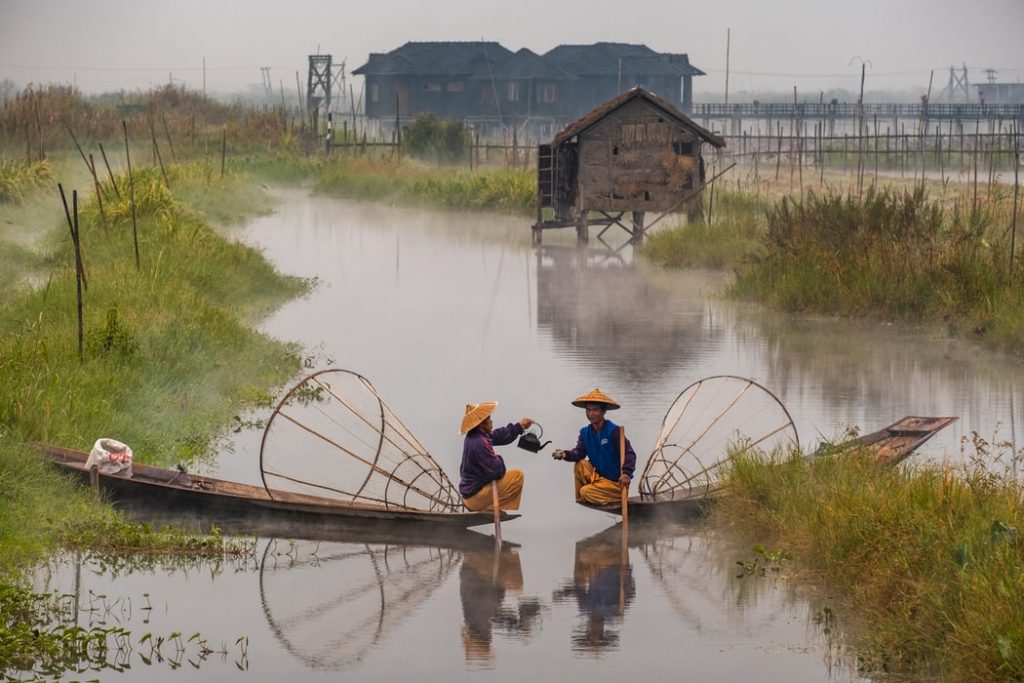Travel to Myanmar: Burmese Culture Survival Guide
If you’re traveling to Myanmar anytime in the near future, you’re probably wondering about the culture and language of this amazing Southeast Asian nation. And while in some ways Myanmar is culturally similar to the surrounding Asian countries of India, China, and Thailand, Burma also retains a great deal of distinctive, original cultural aspects that make it one of the most interesting countries to visit in Southeast Asia.
Because Myanmar has such a unique culture, it can be difficult to know how to behave appropriately as a stranger in a strange land. This survival guide will give you some key things to remember for your trip to Myanmar!

Burmese Food and Eating Etiquette
Burmese food and eating styles are particularly specific to the region. In fact, food is so important in Myanmar that a common greeting is “sa pi pi la:?” which means “have you eaten yet?” in Burmese! To Myanmar people, the meal isn’t finished until they’ve eaten their rice. Rice is usually accompanied by any number of delicious (and often nutritious!) Burmese foods, including curries, salads, and soups. If you’re visiting Myanmar, you can expect to find lapet thoke, or tea leaf salad, on nearly every menu across the country. Usually served as an appetizer or afternoon snack, lapet thoke is both a social activity as well as a way to nourish the body. If you get invited to someone’s home, be sure to graciously accept their offer of lapet thoke and hinn (curry)! Your hosts will be delighted if you enjoy their food.
Myanmar Religion and Beliefs
When it comes to religion, the vast majority of Myanmar people are Theravada Buddhist. Although it shares many characteristics with other sects of Buddhism that westerners are more familiar with (like Tibetan and Mahayana Buddhism), Theravada Buddhism is almost a separate religion altogether. But, besides being the home and heart of Theravada Buddhism, Myanmar also has a rich culture surrounding nats (spirits) and other folkloric rituals and beliefs. The religion and belief system of the Burmese is multilayered and well-worth a read. Contrary to what you might believe, Burmese people will be excited to teach you about their religion! If you ask questions and express an open curiosity, most people will be willing to tell you about Buddhism (and possibly even the nats and spirit culture).
Emotional Expression in Myanmar
Lots of foreigners are surprised by the friendliness of Burmese people. Most of the people you meet on the street (and in the markets, hotels, and restaurants) will be pleased to meet you and will offer up a kind spirit and generous smiles. But while the Burmese are very friendly, they also tend to be shy and reserved. In Myanmar, culture dictates that one should not express a great deal of emotion, whether it be happy, sad, angry, or otherwise. This rule extends into daily life in Myanmar, where it’s uncommon to see couples walking hand-in-hand down the street, or to witness any such display of feeling. For foreigners, the rules can be bent, of course, but this is an important fact to keep in mind during your Myanmar travel adventure.
Myanmar Temples and Pagodas
Temples are major attractions in Myanmar, and it’s very likely that you’ll visit a lot of temples and pagodas when you’re traveling through Burma! From the magnificent Shwedagon Pagoda in Yangon to the temple-dotted fields of Bagan, it’s impossible to travel to Myanmar without at least one visit to a spectacular place of worship. But while you might want to traverse the hallways of every single pagoda, please remember to take off your shoes at the door! Although it’s highly unlikely that anyone will take your shoes while you’re at the pagoda, if you’re concerned about your shoes being stolen, it’s totally acceptable to carry them through. Taking your shoes off is polite and a gesture of respect toward the people, the religion, the culture, and the country.
Polite Greetings in Burma
Americans (and a lot of westerners in general) take it for granted that when you meet someone, you shake hands, hug, or otherwise acknowledge the meeting with some short, carefully coordinated touch. But in Myanmar, shaking hands and hugging are both actions that are highly unusual among strangers, and even among family members! Instead of shaking hands when you meet someone new in Myanmar, a slight nod and a smile, or even a small bow with your hands held together in prayer position will suffice.
Local vs. Foreigner Fees and Prices: Bartering in Myanmar
Unfortunately, throughout Myanmar there are generally fees and higher prices charged to foreigners, so prepare yourself to face entrance fees that are higher than or nonexistent for local Burmese people. In addition, some Myanmar people may choose to charge you, the foreigner, higher prices than they would a local person. In most markets it’s common practice to haggle and barter, so don’t be afraid to try out your skills! But keep in mind that this is happening, and it’s nothing personal. Most Burmese people live in poverty, so it’s understandable that they charge higher prices. Just don’t settle for something that seems exorbitantly unfair.
Myanmar Monks and Nuns
One of the first things that first-time visitors to Myanmar notice is the number of monks (and nuns) who are out roaming the streets, especially during the morning hours. In a country where religion is of the utmost importance, monks are treated with special reverence by the local population. If you ever encounter a monk or nun, remember that it’s not appropriate to touch them in any way, and that sensitive topics should be avoided during conversation if you get the opportunity to speak to them. Every morning, the monks walk through the streets of Myanmar gathering alms and donations from locals, and if you’re ever invited to participate, feel free to give! This is a worthy cause in Myanmar, since it’s often the monasteries that provide education and free lodging to people in need.
Conclusion
Now armed with these key culture facts, you’re ready to go! Myanmar is an amazing country with amazing people, and you’re sure to find plenty of adventure in all the sights and sounds that will surround you during your trip. And don’t be afraid to interact with the locals in Burmese, the official language of Myanmar! Knowing some of the language will go a long ways toward having the trip of a lifetime.
If you’re interested in learning Burmese for your trip to Myanmar, contact BurmeseTutor.com today to schedule your first lesson!
